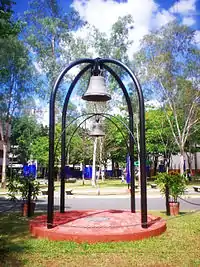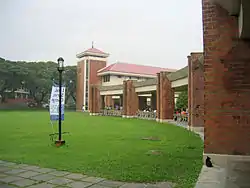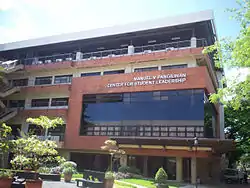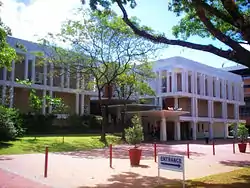History of the Ateneo de Manila
The Ateneo de Manila University (Filipino: Pamantasang Ateneo de Manila; Spanish: Universidad Ateneo de Manila) is a private research university in Quezon City, Philippines. Founded in 1859 by the Society of Jesus, the Ateneo is the third-oldest university in the Philippines.

Background
The founding of the Ateneo de Manila University has its roots in the history of the Society of Jesus (Jesuits) as a teaching order. The first Spanish Jesuits in the Philippines, Alonzo Sánchez and Antonio Sedeño, arrived in 1581 as missionaries. They were custodians of the ratio studiorum, the Jesuit system of education developed around 1559. Within a decade of their arrival, Sedeño and the Jesuits had founded the Colegio de Manila (Colegio Seminario de San Ignacio) in Intramuros, the historic core of Manila in 1590. The Colegio formally opened in 1595, the first school in the Philippines.[1][2]
In 1621, the Colegio de Manila was authorized to confer university degrees in theology and arts by virtue of the privileges conferred by Pope Gregory XV on colleges of the Society of Jesus.[3] In 1623, Philip IV of Spain confirmed the authorization and in 1732 Philip V of Spain founded two regius (royal) professorships in the Colegio, one in canon law and another in civil law, making the school both a pontifical and a royal institution. The Colegio was frequently referred to in contemporary documents as the Colegio Máximo de San Ignacio or Universidad de San Ignacio, the first royal and pontifical university in the Philippines and in Asia.[2][3][4][5][6][7]
However, by the mid-18th century, Catholic colonial powers, notably France, Portugal, and Spain, had grown hostile to the Society of Jesus, in part because the Jesuits actively educated and empowered colonized people, restoring to them a sense of independence. Resentful of the influence the Jesuits had achieved, the colonial powers expelled the Society, often quite brutally, from their realms. In 1768, the Jesuits surrendered the San Ignacio to Spanish civil authorities following their suppression and expulsion from Spain and the rest of the Spanish realm, including the Philippines. Under pressure from Catholic royalty, Pope Clement XIV formally declared the dissolution of the Society of Jesus in 1773.[2][3][4][7]
Pope Pius VII reinstated the Society in 1814, after almost seven decades of persecution and over four decades of formal suppression. However, the Jesuits did not return to the Philippines until 1859, almost a century after their expulsion.[2][3][7]
19th to early 20th century

Through an 1852 Royal Decree from Queen Isabella II, ten Spanish Jesuits arrived in Manila on April 14, 1859, nearly a century after the Jesuits' expulsion from the Philippines. Their mission was to Mindanao and Jolo in the far South.[2][3][4][7] But because of the Jesuits' entrenched reputation as educators among Manila's leaders, on August 5 the Ayuntamiento or city council requested the Governor-General to found and finance a Jesuit school using public funds. On October 1, 1859, he authorized the Jesuits to take over the Escuela Municipal de Manila (transl. Municipal School of Manila), a small private school maintained for some 30 children of Spanish residents. Ten Spanish Jesuit priests and a Jesuit brother began operating the school on December 10, 1859. The Ateneo de Manila University considers this its foundation day.[2]
Partly subsidized by the Ayuntamiento, the Escuela was the only primary school in Manila at the time. The Escuela changed its name to Ateneo Municipal de Manila (transl. Municipal Athenaeum of Manila) in 1865, when it became accredited as an institute of secondary education.[2] It began by offering the bachillerato, as well as certificates in agriculture, surveying, and business. José Rizal, who would later be named a national hero of the Philippines, enrolled for his secondary studies in 1872, and received a Bachelor of Arts degree in 1877, continuing studies at the Ateneo for a license in land surveying.
After Americans occupied the Philippines in the early 1900s, the Ateneo lost its funding from the city and became a private institution. In 1908, the American colonial government recognized the Ateneo de Manila's college status and licensed its bachelor's degree and certificates in various disciplines, such as electrical engineering, making the school now a tertiary institution. The Ateneo campus housed other Jesuit institutions of research and learning, such as the Manila Observatory and the San José Major Seminary.[2][3][4][7][8] In 1909, the Jesuits removed the word "Municipal" from the school's name and it became simply the Ateneo de Manila.[9]
American Jesuits replaced their Spanish brethren in 1921. In 1932, the original campus at Intramuros in Manila was destroyed by fire and the Ateneo moved to the San Jose Major Seminary grounds in Padre Faura, Ermita. The Intramuros campus was rebuilt in 1939. The Ateneo campuses were destroyed again in World War II. Ateneo reopened temporarily in Plaza Guipit in Sampaloc, Manila. The Padre Faura campus reopened in 1946 with Quonset huts serving as buildings among the campus ruins.[10][11] In 1952, William Masterson moved most of the Ateneo units to its present Loyola Heights campus. The Padre Faura campus continued to house the professional schools until 1976. Francisco Araneta was appointed as the Ateneo de Manila's first Filipino rector in 1958. In 1959, its centennial year, Ateneo became a university.[8]
Late 20th century


The following decades saw escalating turbulence engulf the university as an active movement for Filipinization and a growing awareness of the vast gulf between rich and poor gripped the nation. Throughout the 1960s, Ateneans pushed for an Ateneo which was more conversant with the Filipino situation and rooted more deeply in Filipino values. They pushed for the use of Filipino for instruction, and for the university to implement reforms that addressed the growing social problems of poverty and injustice. During that time, the Graduate School split into the Graduate School of Arts and Sciences and the Graduate School of Economics and Business Administration, which eventually became the Graduate School of Business.[12]
In 1965, Fr. Horacio de la Costa became the first Filipino Provincial Superior of the Philippine Province of the Society of Jesus.[13] On September 25, 1969, Pacifico Ortiz, S.J., was installed as the first Filipino President of the Ateneo de Manila.[14]
Ateneans also played a vital role together with student organizations from other prominent colleges and universities as student activism rose in academe in the 1970s. Students faced university expulsion and violent government dispersal as they protested the dismissal of dissenting faculty and students, oppressive laws and price hikes, human rights violations, and other injustices. On September 21, 1972, Philippine President Ferdinand Marcos declared martial law. The university administration had great difficulty reconciling the promotion of social justice and keeping the university intact. They locked down on the more overt expressions of activism—violence and miltancy—and strove to maintain a semblance of normalcy as they sought to keep military men from being stationed on campus.[12][15] In 1973, Jesuit Superior General Fr. Pedro Arrupe called for Jesuit schools to educate for justice and to form "men and women for others."[16] The Ateneo college opened its doors to its first female students in that same year.
The Graduate School of Arts and Sciences moved to Loyola Heights in 1976, and the Padre Faura campus finally closed in 1977 as the Graduate School of Business and the School of Law moved to H.V. de la Costa St. in Salcedo Village, Makati. That same year, the Ateneo, then the "winningest" school in men's basketball, left the NCAA, which it co-founded, due to violence plaguing the league.[12] In 1978 the Ateneo joined the University Athletic Association of the Philippines. In February 1978, the Ateneo opened the Ateneo-Univac Computer Technology Center, one of the country's pioneering computer centers, which later became the Ateneo Computer Technology Center.
On August 21, 1983, Ateneo alumnus Senator Benigno Aquino, Jr., was assassinated upon his return from exile in the United States. Ateneans continued to work with sectors such as the poor, non-government organizations, and some activist groups in the dying years of the martial law era. On February 11, 1986, alumnus and Antique Governor Evelio Javier was gunned down. Two weeks later, Ateneans joined thousands of Filipinos from all walks of life in the peaceful uprising at EDSA which ousted Ferdinand Marcos.[12]
In 1987, nine years after the Ateneo joined the University Athletic Association of the Philippines (UAAP), the university went on to win its first crown in UAAP men's basketball. The Blue Eagles won a second straight title in 1988.[12][14]
In 1991, the Ateneo joined in relief operations to help victims of the eruption of Mt. Pinatubo. That same year saw the School of Law replace its Bachelor of Laws degree with the Juris Doctor degree.
In 1994, the Ateneo was one of the first Philippine schools on the Internet, and was part of the conference that connected the Philippines to the World Wide Web. In 1996 the Ateneo relaunched the Ateneo Computer Technology Center as the Ateneo Information Technology Institute and established the Ateneo School of Government. In 1998, the Ateneo's Rockwell campus, which currently houses the Ateneo Graduate School of Business, the Ateneo School of Law, and the Ateneo School of Government, was completed in Rockwell Center in Bel-Air, Makati. The Science Education Complex was completed in the Loyola Heights campus.
21st century

In 2000, the School of Arts and Sciences which comprised the College and the Graduate School restructured into four Loyola Schools: the School of Humanities, the John Gokongwei School of Management, the School of Science and Engineering, and the School of Social Sciences. The Moro Lorenzo Sports Complex was completed in the Loyola Heights campus. Midway through that year, high school alumnus and Philippine President Joseph Estrada faced grave corruption charges connected with economic plunder and jueteng, an illegal numbers game. The University hosted KOMPIL II and other organizations and movements in its Loyola Heights and Makati campuses. Members of the university community participated in the Jericho March at the Senate and other mass actions.[12] On January 20, 2001 Ateneo alumna and former Economics faculty member Gloria Macapagal-Arroyo was sworn in as the 14th President of the Philippines, overthrowing Estrada after top military officers withdrew support from him as commander in chief.
In April 2002, the office of the University President established Pathways to Higher Education-Philippines, one of the university's outreach initiatives, with the help of the Ford and Synergeia Foundations. On July 31, the feast of St. Ignatius, the University Church of the Gesù was completed in the Loyola Heights campus and was consecrated by Cardinal Jaime Sin. The year also saw the Blue Eagles end a 14-year drought in men's basketball.[17]
In 2003, the Ateneo partnered with Gawad Kalinga in its first formal, university-wide social action program. Also, in response to the typhoons and flooding that devastated most of the Philippine Island of Luzon in November 2004, the Ateneo launched Task Force Noah which has continued to contribute to disaster relief and rehabilitation efforts in areas that include Calatagan in Mindoro and Guinsaugon in Southern Leyte. Also in 2004 the Ateneo earned the highest possible accreditation status, Level IV, from the Federation of Accrediting Agencies of the Philippines and the Philippine Accrediting Association of Schools, Colleges and Universities (PAASCU).[12][18] And the Ateneo celebrated the 145th anniversary of its founding and of the Jesuits' return to the Philippines, even as plans began for its sesquicentennial in 2009.
As typhoon relief efforts wound down in January 2005 the Ateneo, Gawad Kalinga, and other partners launched Kalinga Luzon (KL), a program dedicated to the long-term rehabilitation of typhoon-stricken communities in Luzon.[19] In light of the political crisis sparked by allegations of President Arroyo's cheating in the 2004 presidential elections,[20] Ateneo de Manila in 2005 established the Social Involvement Workshops and other fora. The Ateneo also established more tie-ups and foreign linkages, and began preparation for the Leong Center for Chinese Studies in the university.[21]
In early 2006, members of the Ateneo de Manila University and affiliated Jesuit institutions were part of movements calling for discernment, action, and sustainable solutions to the deeply divisive political issues that continue to rock Filipino society.[22] The Ateneo de Manila University also intensified its social development efforts, launching Kalinga Leyte, a program for the long-term rehabilitation of Southern Leyte, with its GK partners. It expanded the scope of its involvement with Gawad Kalinga, supporting new initiatives throughout Nueva Ecija and in other provinces such as Cotobato and Quezon.[23]

Midway through 2006, the Manuel V Pangilinan Center for Student Leadership was completed.[24] The University also had ground-breaking for several projects: the Ricardo Leong Hall to house several units of the Loyola Schools' School of Social Sciences, the Confucius Institute for Chinese Studies,[25][26] and the Ateneo School of Medicine and Public Health facility in Ortigas. In December, the Ateneo launched AGAP-Bikol in cooperation with other Jesuit-affiliated and civil society groups, in response to the devastation wrought by typhoons in the Bicol area.[27]
In October 2008, 66 faculty members from different departments, including members of the Theology Department, challenged the position of the Catholic Bishops Conference of the Philippines (CBCP) on the Reproductive Health Bill pending before the Philippine Congress, and declared that Catholics can support the RH bill in good conscience. The bill would encourage the use of contraceptives to bring down the large number of abortions in the country.[28] University President Fr. Bienvenido Nebres, S.J., explained that their position was not an official position of the university but that these faculty members had a right to express their views as individual Catholics and that there should be continuing efforts on the critical study and discussion of the bill among Church groups, at the university and in civil society.[29][30][31] In November 2008, the university began work on building a new Rizal Library facility.[32] In December, a new set of university dormitories was inaugurated.[33] The Ateneo High School was granted Level III accreditation by the PAASCU, the highest level in the country.[34]
In September and October 2009, students from the university organised Task Force Ondoy in response to Typhoon Ketsana. The task force conducted relief operations in various areas struck hard by the typhoon, particularly in Marikina City.
In May 2011, the university was granted Level IV Re-Accredited Status and Institutional Accreditation by the Commission on Higher Education (CHED) through the Federation of Accrediting Agencies of the Philippines (FAAP) and the Philippine Accrediting Association of Schools, Colleges and Universities (PAASCU), the first time that both citations were awarded to a university simultaneously.[35] In 2011 Fr. Bienvenido Nebres, S.J., retired from the presidency of Ateneo and was succeeded by Fr. Jose Ramon T. Villarin, S.J. On November 25, 2011 the Philippine Accrediting Association of Schools, Colleges and Universities (PAASCU) awarded the Ateneo de Manila Loyola Schools Level IV Re-accreditation for 21 academic programmemes as well as Institutional Accreditation.[36]
Alumni

Ateneo has graduated two Nobel Peace Prize nominees, two Ramon Magsaysay awardees, and José Rizal, National Hero of the Philippines. Several Philippine Presidents, including the former president Benigno Aquino III, as well as his predecessors Gloria Macapagal-Arroyo, Joseph Estrada, Fidel Ramos, and Corazon Aquino are alumni or have ties with the university. The Ateneo has been associated with three Chief Justices of the Supreme Court, fifteen Senators, one National Scientist, and four National Artists of the Philippines, including Lamberto Avellana and Salvador Bernal. Among its graduates are several leaders of the propaganda movement during the Philippine Revolution against Spain, including Juan Luna.
See also
- Notable alumni of the Ateneo de Manila
- Culture and traditions of the Ateneo de Manila
- Ateneo Blue Eagles
- List of Ateneo de Manila University people
References
- The Ateneo Aegis (Official Yearbook)
- History
- Horacio de la Costa, S.J. The Jesuits in the Philippines.
- Roman A. Cruz, Jr. "The Ateneo Story." Aegis. 1959
- Jose S. Arcilla, S.J. Rizal and the Emergence of the Philippine Nation. Office of Research and Publications, Ateneo de Manila University. 2003. ISBN 971-550-020-X
- Teodoro A. Agoncillo. History of the Filipino People, 8th Edition. Garotech Publishing. 1990. ISBN 971-8711-06-6
- Horacio de la Costa, S.J. Light Cavalry.
- "History". Ateneo de Manila University. Retrieved April 21, 2020.
- "History". Ateneo de Manila University. Retrieved December 6, 2020.
- Soledad S. Reyes. "From the walled city by the sea to the hill over the valley: The Ateneo through the years" The Hill. Maiden Issue. 2004.
- Jaime C. Bulatao, S.J. "Death of A University." Ateneo Alumni Guidon, Vol. VII No. I, Vol. VII No. 2, and Vol. VIII No. 1
- History of the Ateneo de Manila, 2006 and 2007 Executive Planners
- Aegis 1965
- The Guidon (official college newspaper)
- Cristina Jayme Montiel and Susan Evangelista, eds. Down from the Hill: Ateneo de Manila In the First Ten Years Under Martial Law, 1971-1982. Ateneo de Manila University Press. 2005. ISBN 971-550-486-8.
- Fr. Pedro Arrupe, S.J. Men for Others Archived 2006-05-09 at the Wayback Machine
- The Guidon. October 2002.
- The Guidon. October 2005
- Beyond Borders
- KATIPUNAN Magazine. Issue 1, Volume 1, June 2005.
- pre_final_layout_v01-vmc Archived 2006-09-13 at the Wayback Machine
- KATIPUNAN Magazine. March 2006.
- 2006 President's Report
- lsb_aug-sept06 Archived 2007-09-30 at the Wayback Machine
- Ateneo de Manila University
- pre_final_layout.pmd Archived 2007-09-30 at the Wayback Machine
- Ateneo de Manila University
- 66 Ateneo faculty members support RH bill
- "Still Waters - Ateneo on the RH Bill". Lelanddelacruz.multiply.com. Archived from the original on 2011-07-14. Retrieved 2009-05-26.
- Statement on Reproductive Health Bill. Retrieved 26 October 2008.
- Ateneo tells profs to toe line as bishops complain
- "The rise of another iconic structure-the new Rizal Library". Ateneo.edu. Retrieved 2009-05-26.
- "University dorm inaugurated". Ateneo.edu. Retrieved 2009-05-26.
- "Ateneo High School now Level III accredited". Archived from the original on 2015-10-18. Retrieved 2015-10-25.
- "Ateneo de Manila University". Retrieved 17 July 2015.
- "PAASCU grants Loyola Schools Level IV re-accreditation and Institutional Accreditation". Ateneo de Manila University. 3 December 2011. Retrieved 31 August 2015.
Further reading
|
|